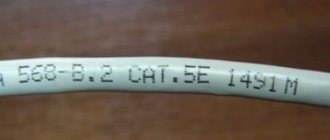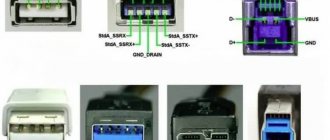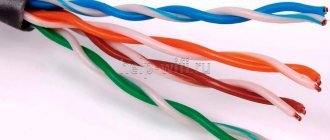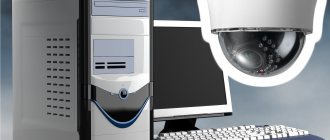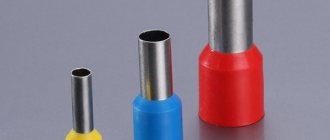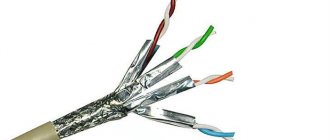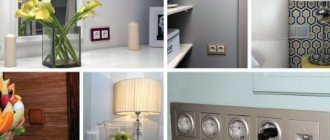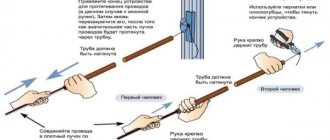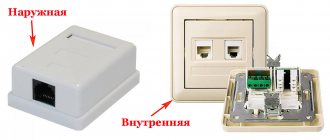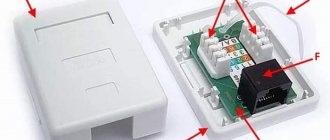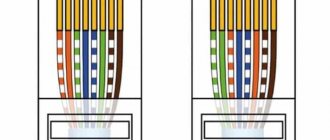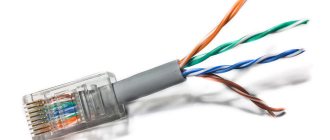When building local networks of various levels and scales, the main connecting interface is a twisted pair cable. 30 years ago he managed to win the coaxial analogue technology war, and today it is the most common type of communication between individual computers and other devices designed to transmit digital data. In particular, it is also used by Internet service providers, delivering network traffic to end consumers.
What is a twisted pair cable?
Interweaving wires in pairs is an invention that is more than 150 years old. Initially, this method of organizing communication was used for telegraph communication, then for a long time twisted pair became the standard for analog telephony. Twisting has proven to be an effective measure to counteract external electromagnetic interference while protecting against internal interference.
Currently, the term “twisted pair” is used primarily in relation to computer networks, having been transformed from two-pair to four-pair.
Structure of a twisted pair cable
Tool-free crimping
The procedure here is the same as in the previous method - the insulation is removed, arranged in the required order, the wires are cut, and inserted into the plug along the grooves. Afterwards, use a screwdriver to press down the part that secures the cable itself, and only after that can you proceed directly to the contacts themselves.
Using the same screwdriver (or scissors, whichever is more convenient), carefully, one by one, crimp the contacts until they pierce the insulation and rest tightly against the conductor cores. The contacts will remain recessed in the grooves of the plastic plug.
But still, of course, a connector crimped using a crimper, even the most budget one, will be of much higher quality. By the way, on new computers and laptops it no longer matters whether the connector is crimped directly or crosswise, because... these models themselves adapt to the pinout. Of course, this does not mean that you can perform such a procedure haphazardly. Simply, if necessary, connecting an Internet modem or another computer can be done by direct crimping a twisted pair or twisted pair 4 cores (at low traffic speeds).
Twisted Pair Categories
The main characteristic of any communications is the data transfer speed. In relation to twisted pair, this characteristic depends to a rather small extent on parameters such as the cable material or its internal topology. But they affect other characteristics of the network - its durability, reliability, maximum permissible signal transmission distance, etc.
The most general characteristic is considered to be the VP category; currently all twisted pair cable manufacturers adhere to this classification. As we have already noted, the determining parameter of computer networks is the speed of information transfer. It depends, first of all, on the frequency of current oscillations, which is the analog method of transmitting a unit of data. For this reason, when dividing cables into categories, one of the main characteristics is the frequency range in which the twisted pair is capable of operating. All other parameters are secondary, aimed at maintaining a given oscillation frequency.
Twisted pair categories:
- CAT1 is characterized by a transmission frequency of up to 10,000 Hz; such a cable was previously called “noodles”. Currently, it is used only for laying a telephone cable into an apartment from a panel installed on the landing.
- CAT2 has a frequency band of up to 1 MHz, which for a four-core cable corresponds to a speed of 4 Mb/s. This wire is used to connect the telephone to the apartment box.
- CAT3 – operates at 16 MHz (10 Mb/s over long distances, 100 Mb/s up to 100 meters).
- CAT4 - 20 MHz cable, practically not used.
- CAT5 is capable of operating at frequencies of about 100–125 MHz (100 Mb/s for two pairs, 1000 Mb/s for four pairs). Currently the most common category for computer twisted pair cables.
- CAT6 has an operating frequency band of about 250 MHz (1 Gb/sec), while the CAT6a variant has an operating frequency of 500 MHz, which corresponds to a speed of 10 Gb/sec.
- CAT7 - a cable capable of operating at frequencies up to 700 MHz, today declared and approved only by the ISO standard
Possible problems and solutions related to network cables
When we talk about network cables we may find ourselves in several situations, before we start with possible problems and solutions, we must rule out software problems of our equipment as well as hardware problems.
Doesn't sync
The main reasons are:
- One of the connectors (or both) is poorly crimped, and there is no electrical connection between the communication source and the destination.
- The network cable is too long, the signal is greatly weakened and a physical connection cannot be established.
- The cable passes through electrical channels and not enough signal reaches it, this is typical with UTP cables if we pass it through these channels.
Sync at 10 Mbps instead of 1 Gbps or more
The main reasons are:
- One of the connectors (or both) is not crimped properly, you need to use a tester to check which PIN is not communicating. It's possible that one or more of them are affected, you'll have to look at which connector is "open".
- The network cable is too long, today we have switches that can transmit a signal up to 250 m long, it is logical that we need a quality cable.
- The cable runs through electrical conduits and there is not enough signal to synchronize at a higher speed.
Sync at 1 Gbps, but sometimes at 100 Mbps
- The network cable is too long, the network "oscillates" and will fluctuate due to the length, set the switch in the middle or change the cable to a higher category so that the signal is not attenuated so much.
- The cable runs through electrical channels, and when too much electricity is required, it disrupts the signal of the network cable. It is recommended to purchase shielded cables or already shielded Category 7 cables.
Twisted pair cable marking
The following markings are generally accepted, indicating the method of organizing shielding:
- UTP – cheap unshielded cable (may be designated U/UTP);
- FTP – a cable in which all pairs had a common shield (F/UTP);
- S-FTP – common double shield for all pairs with foil-coated aluminum core and tinned copper wire conductors (SF/UTP);
- STP – presence of a screen for each pair (U/FTP);
- F/FTP – separate screens for all pairs plus a common screen made of aluminum foil;
- S/FTP – separate screens for all pairs plus a common one made of tinned copper wire.
Types of cable shielding depending on marking
In general, a screen protects a cable from random and systematic interference that distorts the signal; it is necessary to prevent loss of information. Types of shielding indicate different levels of data protection. They largely determine the cost of the finished product.
Types of twisted pair
In addition to markings indicating the presence and method of organizing the screen, there are other designations used by manufacturers to indicate certain technical features of their products:
- Number of cores: solid – single-core cable, patch – multi-core. Monocores are cheap to produce, so they are the most common. Multicore products are used for complex network topologies in places of multiple bends. They are mainly used in the production of patch cords (a section of cable of a given length terminated with jacks for connecting devices).
- Core diameter. The range used is 0.40–0.64 mm. Cable products of categories 5–6 are made from conductors with a diameter of 51 mm and are designated 24AWG (American marking standard). A budget, often uncertified cable is made from 0.40–0.50 mm wire - for an apartment, the choice of such a twisted pair would be quite justified.
- Number of pairs When building complex communication systems, their number can reach thousands, but for computer networks the standard is 4 pairs (the marking accepted in the USA is 4x2x0.51). The use of all eight cores is required to build gigabit networks; for home use with a throughput of up to 100 Mb/s, two pairs are sufficient. And although such a cable is cheaper, usually in any case they purchase the eight-core version. Two pairs are used for arranging intercoms and alarm systems.
Twisted Pair Contents
We should also talk about marking by shell type:
- PVC – polyvinyl chloride sheath, used mainly for cheap cables;
- PP – polypropylene sheath for cables that can be exposed to high temperatures (up to 140° C);
- PE – a sheath made of dense polyethylene, used for external laying of cables;
- FR – fire-resistant category cable (ability to work in case of fire for a certain time, from 30 to 180 minutes);
- LS – a shell made of a material characterized by low smoke emission during fire;
- ZH is a material that does not emit toxic halogen gases when burned;
- B – cable with an armored sheath in the form of an enveloping steel tape.
There are also modifications of the cable with steel cable, which are used for aerial laying of networks between houses.
What about installing fiber optics into your apartment?
The Blonde talked about what fiber optics is here.
The country's providers have already completely updated their network infrastructure, using fiber optics and related technologies to connect subscribers. This is beneficial for many reasons:
- High throughput.
- Kilometer cable length without signal loss.
- Saving space in optical line terminal cabinets (connecting thousands of subscribers from only one OLT).
Also, some providers, for example, Rostelecom, provide the service of installing fiber optics into the apartment. This is a great opportunity to get a high-quality high-speed signal.
But there is one nuance in which optical fiber can be brought into the apartment, and it is better to distribute it to rooms using twisted pair wire. Optical fiber is fragile and does not tolerate sharp bends. If this happens, the signal is lost and does not reach the final destination.
Therefore, to carry it into the apartment, a special fiber-optic cable is used for internal installation with super-flexible fiber and power elements (2), which, after passing through the wall cross-connect (3), is connected to an optical patch cord (4), which is connected to the media converter (1).
The wall cross looks like this inside.
And already from the media converter, it is connected via a twisted-pair cable, which is routed throughout the apartment.
Also, on the market you can find routers with a special PON connector for fiber optics. In this case, the signal propagation medium converter is excluded from the chain.
In this case, the fiber optic cable itself is pulled by the provider from the distribution panel to the apartment. It is configured and connected to the Internet directly by employees of the Internet company. A router or media converter uses this kind of fiber optic patch cord.
Standards, certification
When choosing a twisted pair type, you need to understand for what purpose the cable should be used. The Ethernet standard is the most common; twisted pair is sometimes referred to by this term. The standard defines a number of characteristics of a cable network: data transmission speed, maximum distance possible without the use of signal amplifiers, modulation method, etc. However, optical fiber also applies to the same standard.
There are also separate standards applicable when laying SCS, and for structured cabling systems the requirements are much stricter.
Connecting a twisted pair cable to an Internet outlet
Over a dozen Ethernet standards have been developed, most of them are outdated (for example, 10BASE5, or IEEE 802.3, often called “thick Ethernet”).
A version of the IEEE 802.3ba standard, developed in 2009, allows data transfer at speeds of up to 40 Gb/sec; there is also a 100-gigabit standard, and a terabit standard is expected.
RJ-45 twisted pair connector
There are three popular standards in the field of SCS:
- American version - EIA/TIA-568С;
- the standard used in Europe is CENELEC EN 50173;
- international version of the standard – ISO/IEC IS11801-2002.
Expert opinion.
LAN-ART twisted pair expert - Evgeniy Nikolaevich Berezkin.All standards relating to the construction of structured cabling systems on twisted pair guarantee its performance for 10 years or more.
Procedure for crimping using a crimper
First, you need to strip the outer layer of insulation by about 2.5–3 cm. For such manipulation, there are special recesses on the crimper. In this case, you need to be very careful not to damage the insulation of the twisted pair wires.
Afterwards, you need to carefully straighten the wires, arranging them in the desired sequence, and cut them so that you get an even perpendicular edge. Next, follow the grooves inside the plug and insert the wires inside so that they fit into the contacts of the plug. The outer insulation of the wire must also go inside. Otherwise, after several bends, the connector will not hold up and the wires will break.
Afterwards, you can crimp the wire and the second fastening point with a crimper, which has a special groove for the 8P network cable. If the crimping is sufficient, the contacts pierce the core insulation. This action has two functions: it creates strong contact and additional fixation.
If the instructions are followed exactly, the twisted pair connector will function as intended. If something went wrong, the colors of the cores were mixed up, etc., it is for such a case that the supply of plugs mentioned above is needed.
Methods for determining the quality of a twisted pair cable
To determine which twisted pair cable is best for the Internet, experts advise paying attention to the brand name. Among European manufacturers, it is worth noting Reichle De-Massari (Switzerland), Mollex (USA) has a good cable. The remaining brands found in Russia are mainly from China (or Taiwan), although the labeling may be different if the customer so desires.
The second criterion we pay attention to is the material used to make the cores. Copper is the standard for twisted pair, but recently you can often find bimetallic conductors, which are inferior in quality to copper ones. They are steel (CCS) or aluminum (CCA) wire clad with a thin layer of copper.
Cable composition: twisted pair
Such products are more affordable, but have a number of disadvantages that are not typical for pure copper cores:
- such conductors are not fixed securely enough in the connectors, forming a so-called “floating” contact;
- there is a limitation on the length of bimetallic twisted pair sections (up to 25 meters at 100 meters for a classic copper cable);
- When a twisted pair is inserted into a connector, significant fluctuations in wave impedance are possible, which affects the stability of signal transmission to the end device;
- in case of damage or the need to re-lay the cable, one cannot count on maintaining the previous characteristics;
- for cables with a steel core, the maximum information transfer speed will be within 10 Mb/s, for conductors with an aluminum core – up to 100 Mb/s.
It’s quite simple to make sure that you have a copper-plated vein in front of you. It is enough to try to scrape off the top layer with a knife. If silvery metal appears under the copper, you can rest assured that this is a twisted pair of bimetallic conductors. By the way, it is not possible to solder a copper-plated cable with a regular soldering iron. However, most Internet service providers use this cheaper type of product when laying the cable from the panel to the end user.
Finally, the quality of a twisted pair can be judged by such a characteristic as the thickness of the cores. The larger the diameter, the better the quality of the cable; for well-known manufacturers it ranges from 0.51 mm. A core thickness in the range of 0.4–0.5 mm indicates a low-quality product.
Most often, thinner cores can be seen on a pair of brown and blue colors, since they are not used for 100-Mbit networks.
And the last criterion for quality control is the availability of a certificate. Large manufacturers certify their products, but small ones do not, because it is expensive.
Types of conductors
Wire is made from different materials with different thicknesses. And the price greatly depends on their quality and cross-section.
Material
Copper is considered the canonical metal for wire. But it is quite expensive in itself, and is not always needed for use. Therefore, at the moment you can see three main materials:
- Aluminum. A wire made of aluminum is much lighter and cheaper than copper. These are all its advantages, then there are only disadvantages. The electrical conductivity of aluminum is 1.7 times lower than that of copper. In small areas this is not noticeable, but in long areas bordering on the maximum permissible lengths it can become a serious problem. Connectors may slip off aluminum wires over time. The material is highly susceptible to corrosion and its use is unacceptable in damp rooms or outdoors, since due to corrosion damage the electrical conductivity of the core is significantly deteriorated. Aluminum wire is not as flexible as copper wire, so it is somewhat more difficult to install and easier to damage. The ideal place to use a cable with aluminum conductors is a dry room, for example, an apartment or office, where the cable length does not exceed half that allowed by the standard used. This cable will not power devices using PoE (Power over Ethernet) technology. This technology allows signal and power to be transmitted to the device through this wire;
- Copper-plated aluminum. It is an aluminum cable with a copper layer applied to its surface. This cable is also much lighter than copper, but not so cheap. The difference with copper cable is about 15%. The advantage over pure aluminum cable is improved electrical conductivity and corrosion protection. But even though the conductivity is already much better than that of aluminum, PoE technology does not work well on such a cable;
- Copper. Wire made from copper is heavier and more expensive than all others. But it is precisely this that allows you to squeeze out everything that is intended from the technology used. And it is with the copper version that the throughput of the twisted pair will be maximum. A network built from copper cable will be of the highest quality and most durable.
Conductor design
Conductors can be single-core or multi-core.
- Single-core (Solid). It is a solid core of one conductor. Suitable for transmitting signals over long distances. Suitable for crimping with hand tools;
- Stranded, consists of several conductors twisted in a spiral. More flexible and well suited for making patch cords. Not very suitable for crimping with hand tools.
Section
The thicker the cross-section of the twisted pair core, the more information can be passed through it, and the higher the transmission range. The division into categories already implies that the required wire cross-section will be maintained for the selected cable category. To mark the conductor cross-section, a marking was invented - AWG. This abbreviation is translated into Russian as – American wire gauge. To put it simply, each AWG value has its own core diameter and cross-sectional area. For single-core and multi-core cables these values will be different.
For Cat.5e the standard is 24AWG. This means that for it to work properly, the diameter of each wire must be 0.511 mm, which means a cross-sectional area of 0.205 square meters. mm.
Rating of twisted pair manufacturers
Understanding and remembering all the variety of standards and characteristics of twisted pair cables is quite difficult, especially for an untrained user. Therefore, the question of how and which twisted pair to choose for the home is decided by many based on opinions about the manufacturer. We have compiled a small rating that will help determine the quality and its correspondence to the cost of the Internet cable, depending on the brand.
Premium Twisted Pair
The best twisted pair cable is the most expensive, the cost of 1 meter is in the range of 20–25 rubles. But for the money, you get the highest quality cable that can last for decades. Premium level products are typical for the brands Hyperline, SkyNet, Nikolan.
As a rule, such products are not used for residential Internet - it is installed in government agencies, banks, and other companies with high requirements for network quality.
Mid-level cable
When compared with the top level, twisted pair cable of category 5 costs much less, about 15 rubles/meter, and is characterized by quite decent quality and speed. In Russia, the most popular manufacturer of cable products of this quality is the NetLan brand. The scope of application of twisted pair cables in the mid-price segment is large enterprises and offices, but it can also be seen in the private sector.
Budget twisted pair
When choosing a UTP cable for a home network, most users focus on cost. There is nothing reprehensible about this - products from Chinese brands such as CabLAN or Ripo cost about 5 rubles/meter. In the vast majority of cases, this is a cable with copper-clad cores of appropriate quality, quite suitable for building low-budget networks.
Products with copper conductors from the Middle Kingdom are offered at a price of about 10 rubles/meter, and this is the most suitable option for installing the Internet in residential buildings.
Design features
This wire got its name precisely because of its design features. Several copper wires are insulated from each other using a special twisting method. Thus, a kind of couple is obtained.
As an example, we can consider the option of two wires that are connected together. In most cases, this option is used to gain access to the Internet. In this option, one core will transmit data, and the second will serve as a signal receiver.
These days, optical fiber is often used and consists of many pairs. This is a very convenient way to transfer data for home Internet. Using this type of wire, you can save money if you connect one device to several subscribers. Such savings will not incur a deterioration in quality, although some users believe that the data transfer speed on such equipment is reduced - these are just arguments not supported by facts.
Important! Each twisted pair consists of one conductor, as well as an outer sheath for additional protection. You can also additionally purchase various design additions, for example, special shielding, which will protect the wire from the sun and other external influences.
Summarizing
As has probably become clear, the question of how to crimp a network cable is not so complicated, and anyone can do such work, even without special education. The main thing, as in any work, is attentiveness, accuracy and strict adherence to the instructions (images of various cuts are available above). Therefore, there is no point in calling a master, waiting for him and paying money for work that can be done with your own hands. But if you have doubts about your abilities, then, of course, you can entrust this matter to a professional, but it still won’t hurt to try to do the crimping yourself. After all, the costs for plugs are the smallest, and you can save a lot.
